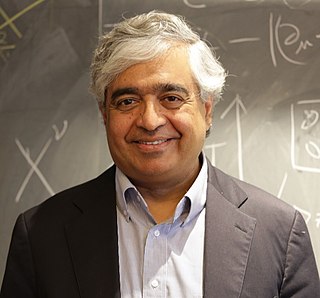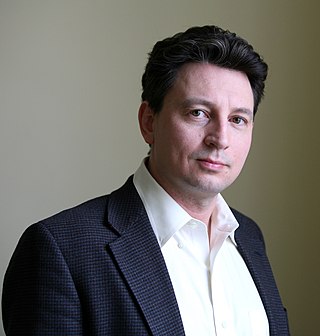Related Research Articles

Condensed matter physics is the field of physics that deals with the macroscopic and microscopic physical properties of matter, especially the solid and liquid phases which arise from electromagnetic forces between atoms. More generally, the subject deals with condensed phases of matter: systems of many constituents with strong interactions among them. More exotic condensed phases include the superconducting phase exhibited by certain materials at extremely low cryogenic temperature, the ferromagnetic and antiferromagnetic phases of spins on crystal lattices of atoms, and the Bose–Einstein condensate found in ultracold atomic systems. Condensed matter physicists seek to understand the behavior of these phases by experiments to measure various material properties, and by applying the physical laws of quantum mechanics, electromagnetism, statistical mechanics, and other physics theories to develop mathematical models.

In physics, topological order is a kind of order in the zero-temperature phase of matter. Macroscopically, topological order is defined and described by robust ground state degeneracy and quantized non-Abelian geometric phases of degenerate ground states. Microscopically, topological orders correspond to patterns of long-range quantum entanglement. States with different topological orders cannot change into each other without a phase transition.
In particle physics, a relativistic particle is an elementary particle with kinetic energy greater than or equal to its rest-mass energy given by Einstein's relation, , or specifically, of which the velocity is comparable to the speed of light .

Sankar Das Sarma is an India-born American theoretical condensed matter physicist, who has worked in the broad research topics of theoretical physics, condensed matter physics, statistical mechanics, quantum physics, and quantum information. He has been a member of the department of physics at University of Maryland, College Park since 1980.
The quantum spin Hall state is a state of matter proposed to exist in special, two-dimensional semiconductors that have a quantized spin-Hall conductance and a vanishing charge-Hall conductance. The quantum spin Hall state of matter is the cousin of the integer quantum Hall state, and that does not require the application of a large magnetic field. The quantum spin Hall state does not break charge conservation symmetry and spin- conservation symmetry.

Xiao-Gang Wen is a Chinese-American physicist. He is a Cecil and Ida Green Professor of Physics at the Massachusetts Institute of Technology and Distinguished Visiting Research Chair at the Perimeter Institute for Theoretical Physics. His expertise is in condensed matter theory in strongly correlated electronic systems. In Oct. 2016, he was awarded the Oliver E. Buckley Condensed Matter Prize.

Subir Sachdev is Herchel Smith Professor of Physics at Harvard University specializing in condensed matter. He was elected to the U.S. National Academy of Sciences in 2014, and received the Lars Onsager Prize from the American Physical Society and the Dirac Medal from the ICTP in 2018. He was a co-editor of the Annual Review of Condensed Matter Physics from 2017–2019.

A topological insulator is a material whose interior behaves as an electrical insulator while its surface behaves as an electrical conductor, meaning that electrons can only move along the surface of the material.
Bismuth selenide is a gray compound of bismuth and selenium also known as bismuth(III) selenide.

Shoucheng Zhang was a Chinese-American physicist who was the JG Jackson and CJ Wood professor of physics at Stanford University. He was a condensed matter theorist known for his work on topological insulators, the quantum Hall effect, the quantum spin Hall effect, spintronics, and high-temperature superconductivity. According to the National Academy of Sciences:
He discovered a new state of matter called topological insulator in which electrons can conduct along the edge without dissipation, enabling a new generation of electronic devices with much lower power consumption. For this ground breaking work he received numerous international awards, including the Buckley Prize, the Dirac Medal and Prize, the Europhysics Prize, the Physics Frontiers Prize and the Benjamin Franklin Medal.

Laurens W. Molenkamp is a professor of physics and Chair of Experimental Physics at the University of Würzburg. He is known for his work on semiconductor structures and topological insulators.
The EPS CMD Europhysics Prize is awarded since 1975 by the Condensed Matter Division of the European Physical Society, in recognition of recent work by one or more individuals, for scientific excellence in the area of condensed matter physics. It is one of Europe’s most prestigious prizes in the field of condensed matter physics. Several laureates of the EPS CMD Europhysics Prize also received a Nobel Prize in Physics or Chemistry.

Charles L. Kane(Charles Lewis Kane) is a theoretical condensed matter physicist and is the Christopher H. Browne Distinguished Professor of Physics at the University of Pennsylvania. He completed a B.S. in physics at the University of Chicago in 1985 and his Ph.D. at Massachusetts Institute of Technology in 1989. Prior to joining the faculty at the University of Pennsylvania he was a postdoctoral associate at IBM's T. J. Watson Research Center working with his mentor Matthew P. A. Fisher, among others.

Dirac cones, named after Paul Dirac, are features that occur in some electronic band structures that describe unusual electron transport properties of materials like graphene and topological insulators. In these materials, at energies near the Fermi level, the valence band and conduction band take the shape of the upper and lower halves of a conical surface, meeting at what are called Dirac points.
The term Dirac matter refers to a class of condensed matter systems which can be effectively described by the Dirac equation. Even though the Dirac equation itself was formulated for fermions, the quasi-particles present within Dirac matter can be of any statistics. As a consequence, Dirac matter can be distinguished in fermionic, bosonic or anyonic Dirac matter. Prominent examples of Dirac matter are Graphene, topological insulators, Dirac semimetals, Weyl semimetals, various high-temperature superconductors with -wave pairing and liquid Helium-3. The effective theory of such systems is classified by a specific choice of the Dirac mass, the Dirac velocity, the Dirac matrices and the space-time curvature. The universal treatment of the class of Dirac matter in terms of an effective theory leads to a common features with respect to the density of states, the heat capacity and impurity scattering.
Magnetic topological insulators are three dimensional magnetic materials with a non-trivial topological index protected by a symmetry other than time-reversal. In contrast with a non-magnetic topological insulator, a magnetic topological insulator can have naturally gapped surface states as long as the quantizing symmetry is broken at the surface. These gapped surfaces exhibit a topologically protected half-quantized surface anomalous Hall conductivity perpendicular to the surface. The sign of the half-quantized surface anomalous Hall conductivity depends on the specific surface termination.

Victor Galitski is an American physicist, a theorist in the areas of condensed matter physics and quantum physics.
Photonic topological insulators are artificial electromagnetic materials that support topologically non-trivial, unidirectional states of light. Photonic topological phases are classical electromagnetic wave analogues of electronic topological phases studied in condensed matter physics. Similar to their electronic counterparts, they, can provide robust unidirectional channels for light propagation.
Nai Phuan Ong is an American experimental physicist, specializing in "condensed matter physics focusing on topological insulators, Dirac/Weyl semimetals, superconductors and quantum spin liquids."
Bogdan Andrei Bernevig is a Romanian Quantum Condensed Matter Professor of Physics at Princeton University and the recipient of the John Simon Guggenheim Fellowship in 2017.
References
- ↑ "Charles Kane, Eugene Mele: John Scott Award". The University of Pennsylvania Almanac. Retrieved 11 January 2022.
- ↑ "Eugene Mele". www.physics.upenn.edu. Retrieved 20 October 2018.
- ↑ Kane, C.L.; Mele, E.J. (25 November 2005). "Quantum Spin Hall Effect in Graphene". Physical Review Letters. 95 (22): 226081. arXiv: cond-mat/0411737 . Bibcode:2005PhRvL..95v6801K. doi:10.1103/PhysRevLett.95.226801. PMID 16384250. S2CID 6080059.
- ↑ Kane & Moore (2011).
- ↑ "Breakthrough Prize – Winners of the 2019 Breakthrough Prize in Life Sciences, Fundamental Physics and Mathematics Announced". Breakthrough Prize. 17 October 2018. Retrieved 20 October 2018.
- ↑ "Eugene J. Mele". The Franklin Institute. 27 October 2014. Retrieved 20 October 2018.
- ↑ "EPS Condensed Matter Division Europhysics Prize - Award recipients" (PDF). European Physical Society. 28 September 2017. Retrieved 20 October 2018.
- ↑ "APS Fellow archive". APS. Retrieved 20 September 2020.